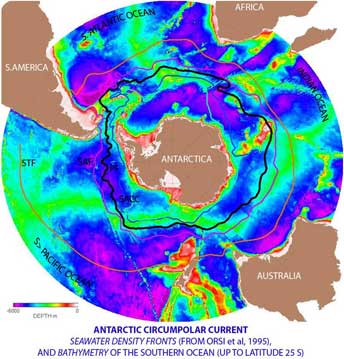If you ever want to drop a boat in the water and let the currents carry you around the world, there’s only one place to go: Antarctica. A wide, deep current circles the entire continent. It’s the only current that will carry you all the way around the globe.
 Illustration of the Antarctic Circumpolar Current. Credit: Wikipedia
Illustration of the Antarctic Circumpolar Current. Credit: WikipediaThe Antarctic Circumpolar Current was discovered more than three centuries ago by Edmond Halley, for whom Halley’s Comet is named. But scientists didn’t begin to study the current until the last half of the 20th century.
The current is driven eastward by strong winds. The current travels at an average speed of about a mile an hour. It would go even faster, but it loses speed as it flows over ridges and plateaus far below the surface.
Even though it’s not in a hurry, the current carries a lot of water -- about 150 times more water than all the world’s rivers put together. The water comes from all the major oceans, so the Antarctic Current acts as a sort of blender, mixing the waters and spitting some of them back out again.
On average, water in the current is colder than that of the oceans to its north. But the surface temperature can vary by several degrees. In part, that’s because a long, shallow wave travels along the current. It has two peaks and troughs. At the peaks, the water is a little warmer than average; at the troughs, it’s a little cooler. This wave may act as an “El Niño” of the Southern Ocean, influencing rainfall patterns across far-southern latitudes -- carrying changes in the weather all the way around the world.

